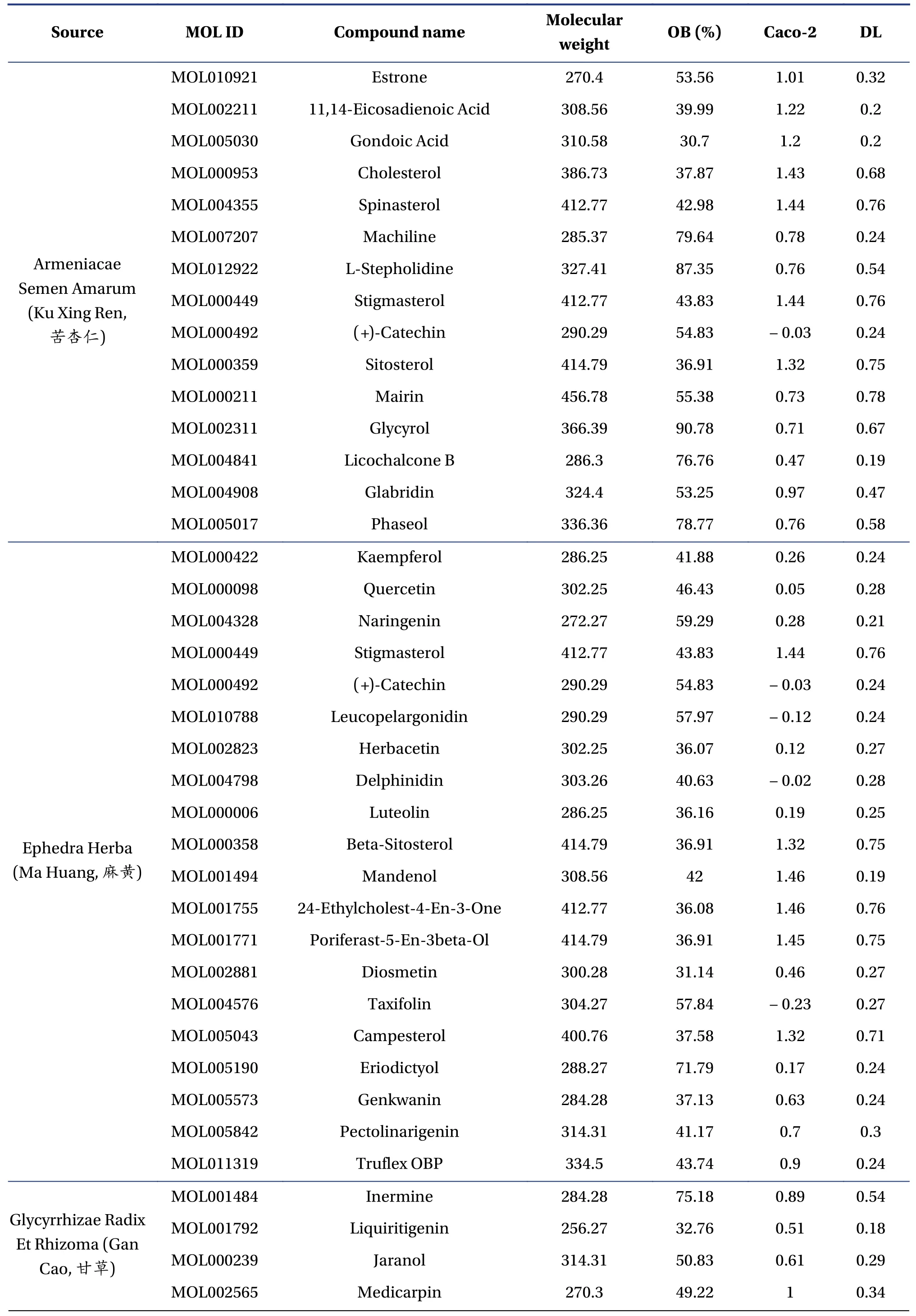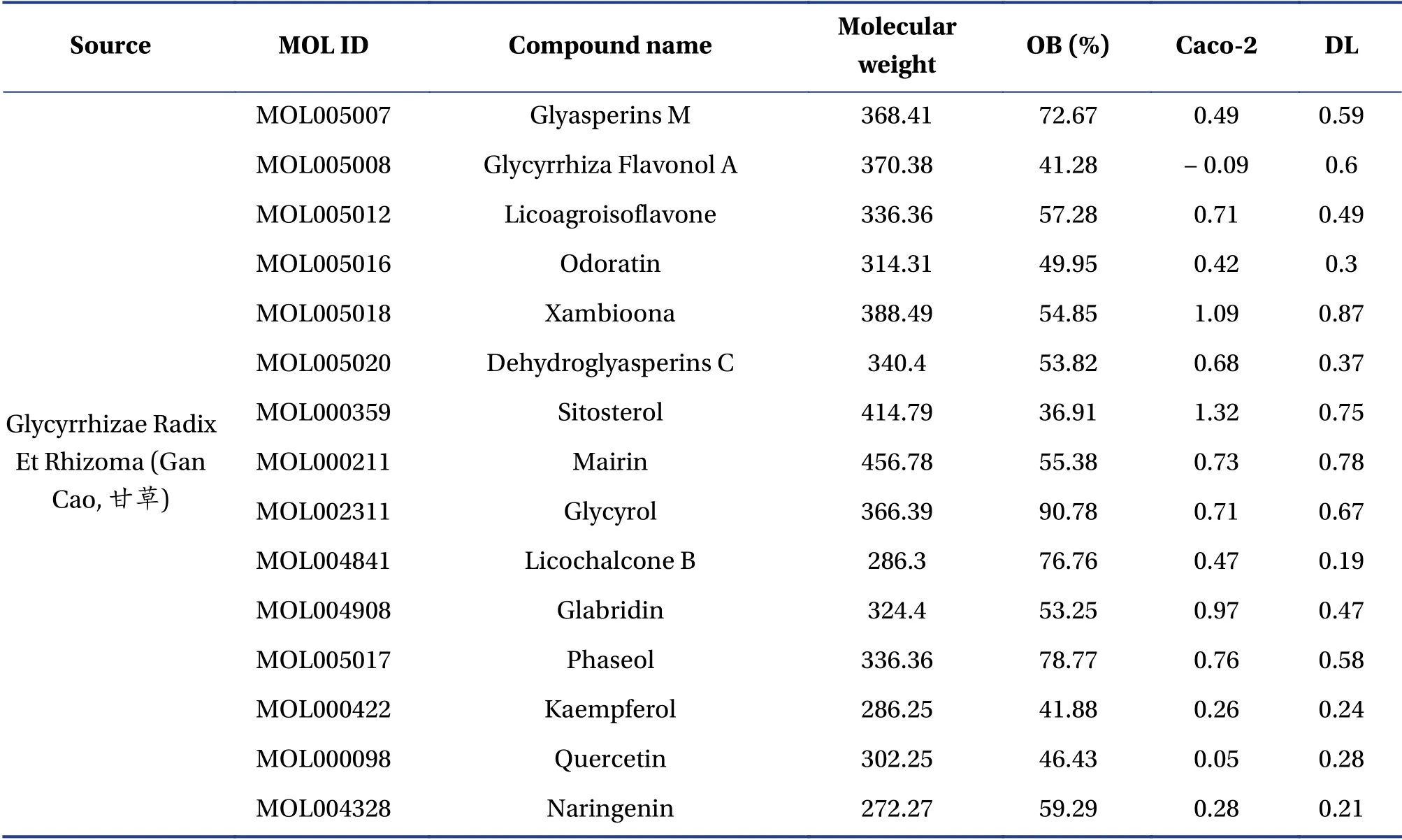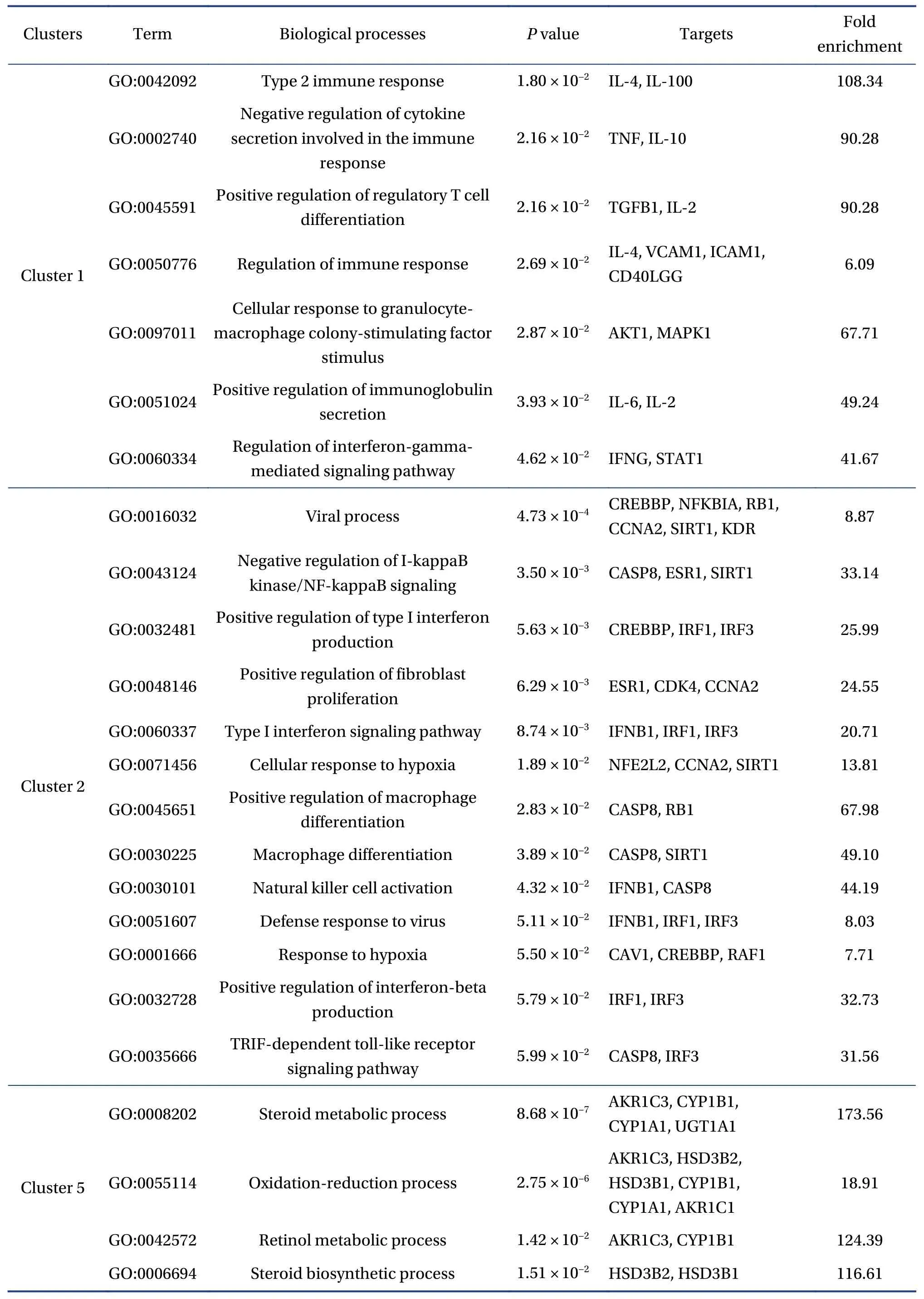Systematic Pharmacological Strategies to Explore the Regulatory Mechanism of Ma Xing Shi Gan Decoction on COVID-19
2020-09-26ZHANGShiYingLILingZHANGNingXIAHongToLUFngGuoLIWiQing
ZHANG Shi-Ying,LI LingZHANG Ning,XIA Hong-To,LU Fng-Guo*,LI Wi-Qing*
b.Department of Traditional Chinese Medicine,Shenzhen Luohu People’s Hospital,Shenzhen,Guangdong 518001,China
c.Department of Traditional Chinese Medicine,The Third Affiliated Hospital of Shenzhen University,Shenzhen,Guangdong 518001,China
d.Department of Respiratory Disease,Shenzhen Luohu People’s Hospital,Shenzhen,Guangdong 518001,China
e.Department of Respiratory Disease,The Third Affiliated Hospital of Shenzhen University,Shenzhen,Guangdong 518001,China
Keywords
Coronavirus disease 2019 (COVID-19)
Ma Xing Shi Gan Decoction (MXSGD)
Network pharmacology
Mechanism
ACE2 receptor
ABSTRACT
Objective To use systematic pharmacological strategies to explore the regulatory mechanisms of Ma Xing Shi Gan Decoction (MXSGD) against the coronavirus disease 2019(COVID-19).
Methods Data on the compounds and targets of MXSGD were collected from the Traditional Chinese Medicene Systems Parmacology Database and Analysis Platform (TCMSP) and TCM Databases@Taiwan.Data on ACE2-related targets and the protein-protein interaction (PPI) were collected from the String database.The Cytoscape 3.7.2 was used to construct and analyze the networks.The DAVID platform was used for Gene Ontology(GO) and pathway enrichment analyses.
Results Data on 272 MXSGD targets and 21 SARS-CoV-2 potential targets were collected.Four networks were constructed and analyzed based on the data:(1) compound-target network of MXSGD; (2) MXSGD-SARS-CoV-2-PPI network; (3) cluster of MXSGD-SARS-CoV-2-PPI network; (4) Herb-Pathway-Target network.The core targets included AKT1,MAPK3,IL-6,TP53,VEGFA,TNF,CASP3,EGFR,EGF and MAPK1.The antiviral biological processes were inflammatory responses (inflammatory cells,inflammatory cytokines and their signaling pathways),immune responses (T cells,monocytes,B cells and other immune cells),immune factors (IFN-γ,TNF-α and so on),virus defense,humoral immunity and mucosal innate immune response.The antivirus-related signaling pathways included TNF,NOD-like receptor,FoxO,PI3K-AKT and Toll-like receptor signaling pathways.
Conclusions MXSGD can control disease progression by regulating multiple compounds and targets; it can reduce inflammation and balance immunity by regulating several proteins that interact with ACE2 and signaling pathways closely related to disease development.
1 Introduction
The coronavirus disease 2019 (COVID-19),caused by the severe acute respiratory syndrome coronavirus 2(SARS-CoV-2),has placed a huge burden on medical resources due to its high contagiousness,long incubation period,and the general susceptibility of the population[1].However,the current treatment of COVID-19 is mainly palliative,and prompt and effective treatment planning at various stages of its course is challenging[2].
In 2003,traditional Chinese medicine (TCM)showed satisfactory treatment outcomes in the early stages of the SARS epidemic[3].Since the third edition of "Diagnosis and Treatment Protocol for COVID-19" was released,TCM has been recommended for the treatment of COVID-19[4].The National Health Commission and the State Administration of Traditional Chinese Medicine jointly announced that TCM can reduces fever symptoms,glucocorticoid dosage,and complications and controls disease progression.In various versions of the “Diagnosis and Treatment Protocol for COVID-19” and according to the theory of TCM,COVID-19 is caused by epidemic Qi and the disease is localized within the lungs.The basic pathogenesis is “wet,heat,poison and blood stasis”.The basic prescriptions for dampness and stagnation of the lungs include Ephedra Herba (Ma Huang,麻黄),Armeniacae Semen Amarum (Ku Xing Ren,苦杏仁),Tsaoko Fructus (Cao Guo,草果),Forsythiae Fructus (Lian Qiao,连翘),Atractylodis Rhizoma (Cang Zhu,苍术) and Glycyrrhizae Radix Et Rhizoma (Gan Cao,甘草).The basic prescriptions for the syndrome of pathogenic toxin blockage of the lungs include Armeniacae Semen Amarum (Ku Xing Ren,苦杏仁),Gypsum Fibrosum (Shi Gao,石膏),Trichosanthis Fructus (Gua Lou,瓜蒌),Rhei Radix Et Rhizoma (Da Huang,大黄),Ephedra Herba (Ma Huang,麻黄) and Glycyrrhizae Radix Et Rhizoma(Gan Cao,甘草).The basic prescriptions for the syndrome of pathogenic heat congesting the lung include Ephedra Herba (Ma Huang,麻黄),Armeniacae Semen Amarum (Ku Xing Ren,苦杏仁),Gypsum Fibrosum (Shi Gao,石膏),Fritillariae Thunbergii Bulbus (Zhe Bei Mu,浙贝母) and Glycyrrhizae Radix Et Rhizoma (Gan Cao,甘草).The basic prescriptions are mainly Ephedra Herba (Ma Huang,麻黄),Armeniacae Semen Amarum (Ku Xing Ren,苦杏仁),Glycyrrhizae Radix Et Rhizoma (Gan Cao,甘草)and Gypsum Fibrosum (Shi Gao,石膏) from Ma Xing Shi Gan Decoction (MXSGD).Meanwhile,the herbal formula Qing Fei Pai Du Decoction,which has good curative effects,is also mainly composed of MXSGD[5].
This research group has conducted in-depth research on the antiviral and immunoregulatory mechanisms of MXSGD.In vitromodels have shown that MXSGD can directly inhibit influenza virus replication; it has better virus adsorption inhibitory and host cell-protective effects than ribavirin[6,7].MXSGD can also down-regulate IFN-α/βsecretion and protein expression of influenza virus-infected macrophages[8].In vivoanimal experiments showed that MXSGD can inhibit the activation of the TLR4-MyD88-TRAF6 signaling pathway and alleviate lung injury caused by influenza A virus in infected mice[9].In summary,MXSGD has demonstrated satisfactory effects against influenza viruses.The use of bioinformatics coupled with the establishment of large network databases and the development of pharmacological computer simulation technologies facilitate significant progress in pharmacology[10].This is consistent with the overall system theory of TCM for treating diseases[11,12].We used bioinformatics to explore the pharmacological mechanisms and effectiveness of MXSGD in the treatment of COVID-19-related pneumonia and provide theoretical guidance and support for clinical use.
2 Materials and Methods
2.1 The bioactive compounds and targets of MXSGD
Using “Armeniacae Semen Amarum” “Glycyrrhizae Radix Et Rhizoma” “Ephedra Herba” “Gypsum Fibrosum” as keywords,the compounds of MXSGD were searched and collected from the TCM Database@Taiwan (http://tcm.cmu.edu.tw/zh-tw/index.php)[13]and Traditional Chinese Medicene Systems Parmacology Database and Analysis Platform (TCMSP) (http://tcmspw.com/index.php)[14].Data on the pharmacokinetic parameters and these MXSGD targets were collected from TCMSP.Pharmacokinetic parameters included oral bioavailability (OB),Caco-2 permeability,and druglikeness (DL).OB and Caco-2 permeability indicate the degree of absorption of a compound into the blood after oral administration[15,16].DL,which refers to the similarity of a compound to a known drug,indicates the likelihood that the compound will become a drug[17].According to the standards provided by the TCMSP database,all compounds were filtered,using OB > 30%,Caco-2 > − 0.4,and DL > 0.18 as standards,to obtain orally absorbable MXSGD compounds with pharmacological activity[14].Finally,a total of 110 MXSGD bioactive compounds with targets were obtained.The details of each compound are shown in Table 1.The name of the collected target protein was imported into UniProtKB (http://www.uniprot.org/),and the species was limited to “Homo sapiens” to allow the corrections of the names of the proteins to their official symbols.
2.2 SARS-CoV-2 target and protein-protein interaction (PPI) data collection
The OMIM database (http://omim.org/) and Genecards (http://www.genecards.org) were used to collect data on the targets of SARS-CoV-2[18,19].Meanwhile,this study would also use the String database to collect PPI data for the targets of MXSGD and SARS-CoV-2.When collecting data,the species were limited to “Homo sapiens” with a confidence level of > 0.4[20].
2.3 Network construction and analysis methods
The MXSGD target,SARS-CoV-2 potential target,and PPI data were imported into the network visualization software,Cytoscape 3.7.2,to build and analyze the networks[21].In the network,a node represents the active compound,target or pathway,and nodes are connected by edges.The meaning of an edge varies with networks[21].The degree represents the number of connections between nodes,and betweenness represents the number of shortest paths through nodes[21].In a large PPI network,there are dense areas of some molecular complexes,which are defined as clusters.In the MXSGD-SARS-CoV-2-PPI network,clusters can be considered as functional modules.It is possible to treat diseases by interacting with these functional modules[21].The plug-in MCODE of Cytoscape 3.7.2 can analyze the PPI network to find clusters.
2.4 Gene Ontology (GO) and pathway enrichment analysis
GO and pathway enrichment analyses can demonstrate the importance of different biological processes and signaling pathways in the PPI network[22].In this study,the DAVID platform version 6.8(https://david-d.ncifcrf.gov) was used to perform GO enrichment and pathway enrichment analyses,and the results were displayed with network and bubble diagrams[22].
3 Results
3.1 The MXSGD and SARS-CoV-2 potential targets
A total of 272 MXSGD targets were obtained from TCMSP; Glycyrrhizae Radix Et Rhizoma (Gan Cao,甘草) had 227 targets,Armeniacae Semen Amarum (Ku Xing Ren,苦杏仁) had 71 targets,Ephedra Herba (Ma Huang,麻黄) had 215 targets and Gypsum Fibrosum(Shi Gao,石膏) had 0 targets.Meanwhile,a total of 21 targets related to SARS-CoV-2-infected cells were collected.There is some overlap between the MXSGD and the SARS-CoV-2 potential target sets (Figure 1).
The relationship between the compounds and potential targets of MXSGD is shown in Figure 2.This network is composed of 110 compound nodes,251 target nodes,and 2 069 edges.In this network,some targets can be regulated by a lot of compounds:PTGS2 (94 edges),ESR1 (79 edges),CALM1 (75 edges),CALM2 (75 edges),CALM3 (75 edges),AR (70 edges)and NOS2 (69 edges).Some targets are also regulated by fewer compounds; PYGM,RAF1,RASA1,RASSF1 and RUNX1T1 are each regulated by one compound.Meanwhile,several compounds can regulate a lot of targets:Quercetin (145 edges),Kaempferol (62 edges),Luteolin (55 edges),7-Methoxy-2-methyl isoflavone (43 edges),Formononetin (38 edges) and Isorhamnetin (35 edges).Several compounds can also regulate fewer targets:each of Icos-5-enoic acid,Gadelaidic acid and Mairin can only regulate one target.
3.2 Analysis of the MXSGD-SARS-CoV-2-PPI network
The MXSGD-SARS-CoV-2-PPI network consists of 272 nodes (241 MXSGD target nodes,23 SARS-CoV-2 potential target nodes,and 8 MXSGD-2019nCoV target node) and 5 541 edges (Figure 3).The targets are arranged in descending order of Degree.The top 10 targets of each target group are:(1) MXSGD targets:AKT1 (163 edges),IL-6 (147 edges),MAPK3(144 edges),TP53 (142 edges),TNF (134 edges),VEGFA (127 edges),JUN (122 edges),EGFR (121 edges),MAPK1 (118 edges) and MAPK8 (118 edges);(2) SARS-CoV-2 targets:CREB1 (99 edges),CCL5 (74 edges),CREBBP (62 edges),IRF3 (44 edges),IFNB1(40 edges),LCN2 (29 edges),ATF2 (28 edges),IFNA1(25 edges),MX1 (20 edges),BAG3 (18 edges) andCASP6 (18 edges); (3) MXSGD-SARS-CoV-2 targets:CASP3 (123 edges),FOS (109 edges),IL10 (92 edges),CCL2 (92 edges),BCL2L1 (78 edges),IFNG (68 edges),CXCL10 (63 edges) and DPP4 (29 edges).

Table 1 Information of active compounds in MXSGD

Table 1 Continued
3.3 Biological processes of the MXSGD-SARS-CoV-2-PPI network
The MXSGD-SARS-CoV-2-PPI network was analyzed using MCODE,and 12 clusters were found (Table 2 and Figure 4).The targets in the clusters were input into DAVID to perform GO enrichment analysis,and several biological processes were discovered.
Cluster 1 is related to inflammatory responses (inflammatory cells,inflammatory cytokines,and their signaling pathways),immune responses (T cells,monocytes,B cells and other immune cells),immune factors (including IFN-γand TNF-α),virus defense,humoral immunity,and mucosal innate immune response.Cluster 2 is associated with leukocyte migration.Cluster 5 is involved in steroid metabolism.Cluster 3,4,6,7,8,9,10,11 did not return any antiviral biological processes.The biological processes are shown in Figure 5 and Table 3.
3.4 Herb-Pathway-Target network analysis
The targets of the MXSGD-SARS-CoV-2-PPI network were input into DAVID to perform pathway enrichment analysis,and 10 antiviral signaling pathways were returned (Figure 6 and 7).Of the targets in this network,Glycyrrhizae Radix Et Rhizoma (Gan Cao,甘草) could regulate 72,Ephedra Herba (Ma Huang,麻黄) could regulate 70,and Armeniacae Semen Amarum (Ku Xing Ren,苦杏仁)could regulate 13.This indicates that Ephedra Herba(Ma Huang,麻黄) and Glycyrrhizae Radix Et Rhizoma (Gan Cao,甘草) may have the most important antiviral properties,while Armeniacae Semen Amarum (Ku Xing Ren,苦杏仁) may be supportive.The fold enrichment andPvalue,among others,of all signaling pathways are shown in Table 4 and Figure 7.The most important of those signaling pathways is the TNF,and Figure 8 shows that MXSGD can regulate multiple targets in the TNF pathway.
4 Discussion
This study used bioinformatics to construct and analyze the MXSGD compound-target,MXSGDSARS-CoV-2-PPI and Herb-Pathway-Target networks.It revealed the multi-path and multimolecular target mechanisms of MXSGD against COVID-19,which provides a basis for clinical use.In TCM,clinical diagnosis and treatment are based on syndrome differentiation.TCM associates the attributes of herbs with human meridians and collaterals and demonstrates the selectivity of herbs for the viscera to guide clinical practice[23].Under the theoretical framework of TCM,COVID-19 belongs to the fiels of the plague of dampness pathogen.Theetiology attribute is “pathogen of damp toxin”.The disease is localized in the lung and spleen,and the basic pathogenesis is characterized as “wet,poison,stasis and closure”[24].The results of pathological anatomy also confirmed that the damage caused by the new coronavirus is mainly in the lungs[25].

Table 2 Clusters of the MXSGD-SARS-CoV-2-PPI network
By analyzing the MXSGD-SARS-CoV-2-PPI network,we found that some targets of MXSGD can interact with ACE (including ESR1,PTGS2,CAT,PPARG,NOS2,F2,NOS3,KDR,ADRA1B,ADRB2,ADRA1D,NR3C2,ACHE,SLC6A4,ADRB1,HMOX1,ADRA1A,PON1 and NPEPPS).Other targets can interact with ACE2 (CAT,NOS3,NR3C2,ACHE,LTA4H,NCF1,CDK4,IL-6,MAPK3,HIF1A,CRP,NPEPPS,CALM1,CALM2 and CALM3).Those indicate that MXSGD may regulate the expression of ACE2 receptors in various organs affected by COVID-19.
SARS-CoV-2 can induce inflammatory storms.When it infects the human body,it can invade cells through ACE2[26].The lung tissues that highly express ACE2 and are externally exposed become the main targets.Immune cells in the lung are over-activated,and they produce several inflammatory factors,such as interferon (IFN),interleukin (IL),chemokines,colony-stimulating factors (CSFs),tumor necrosis factor (TNF)[27].These cytokines are secreted by certain immune cells,and they may promote or inhibit inflammation.They maintain a balanced state within the normal human body[28].Proinflammatory factors can activate and recruit other immune cells.Immune cells can secrete more cytokines and activate and recruit more immune cells,thus forming a positive feedback loop that leads to an inflammation storm.Eventually,several immune cells and the interstitial fluid accumulate in the lungs,which block the gas exchange between alveoli and capillaries,resulting in acute respiratory distress syndrome and death in many patients[29].The current study found that MXSGD can regulate inflammatory responses (GO:0006954,GO:0050727,GO:0002674),immune factors and their mediated pathways (including IFN-γ,TNF-α,IL-1 and IL-6) (GO:0071347),and the activation,proliferation and chemotaxis of immune cells (macrophages,T cells,B cells,white blood cells and so on) (such as GO:0050852,GO:0042110,GO:0010818,GO:0030225,GO:0006955).Our previous research also showed that MXSGD can effectively reduce lung inflammation,protect immune organs and regulate cytokine balance,which constitute the possible mechanisms for alleviating lung injury in mice caused by the inhibition of the TLR4-MyD88-TRAF6 signaling pathway by influenza A viruses[9].Recent studies have shown that patients with COVID-19 often have concomitant influenza and parainfluenza virus infections,especially in severe cases; hence,treatment for multiple infections is required.Our previous research provided valuable insights into the antiviral and antibacterial properties of MXSGD; it revealed that MXSGD can inhibit the replication of the influenza virus by regulating the body's immunity[30].In addition,the results of pathway enrichment analysis showed that MXSGD can inhibit immune factors and prevent excessive immune response by regulating the TNF,NOD-like receptor,FoxO,PI3K-AKT,Toll-like receptor,T cell receptor,NF-kappa B,B cell receptor and Jak-STAT signaling pathways,as well as Fc gamma R-mediated phagocytosis.
According to the current "Diagnosis and Treatment Protocol for COVID-19" (Trial Version 5-7) issued by the National Health Commission,MXSGD is recommended for the treatment of severe cases (especially for the patients with the syndrome of epidemic virus attacking lung)[31].Recent studies have shown that severe cases have a higher proportion of cytokine storms,leading to worse prognoses[32].Examination of blood cytokines in severe cases revealed that the D-dimer increase,while peripheral blood lymphocytes progressively decrease; their cytokines IL-2,IL-7,IL-10,GCSF,IP10,MCP1,MIP1A and TNF-αare also higher than normal[33].Such high levels of pro-inflammatory cytokines may cause shock and damage to the heart,liver and kidneys,as well as respiratory or multiple organ failure.The aforementioned cytokines also extensively mediate lung pathological changes,which may result in extensive infiltration of neutrophils and macrophages,and subsequent diffuse alveolar injury[34,35].
WEI et al.[36]conducted a comprehensive immunological analysis of the blood samples of 33 COVID-19 patients and found the key mechanism for the inflammatory storm.After SARS-CoV-2 infection,pathogenic T cells are rapidly activated,producing cytokines such as GM-CSF and IL-6.GM-CSF further activates CD14+and CD16+inflammatory monocytes,thereby producing a large amount of IL-6 and other inflammatory factors.This facilitates the formation of an inflammatory storm and results in severe lung and immune system damage[37].Therefore,IL-6 and GM-CSF are the two key inflammatory factors that trigger the inflammatory storm in patients with COVID-19[38].

Table 3 Biological processes of the MXSGD-SARS-CoV-2-PPI network

Table 3 Continued

Table 3 Continued

Table 4 Signaling pathways of the MXSGD-SARS-CoV-2-PPI network
In summary,the main mechanism of MXSGD in the treatment of patients with severe COVID-19 pneumonia is the regulation of biological modules,such as the inflammatory and immune biological modules.Our previous studies demonstrated the inhibition of inflammatory storms in the H1N1 influenza mouse model by MXSGD.A recent research also showed that Lian Hua Qing Wen Capsule,composed of MXSGD and Yin Qiao Powder,can significantly inhibit the replication of SARS-CoV-2 in Vero E6 cells at the mRNA level and the production of pro-inflammatory cytokines (TNF-α,IL-6,CCL-2/MCP-1 and CXCL-10/IP-10)[39].In addition,Lian Hua Qing Wen Capsule treatment can cause abnormal morphological changes within virus particles in the cells[39].
More importantly,our previous research on influenza A virus found that,the MXSGD clinical equivalent dose,and twice of it,can reduce the levels of TNF-αand IL-4,significantly increase the thymus and spleen indexes,and improve the pathological damage of the lung tissues[40].In the comprehensive management of COVID-19,MXSGD and its modified formulae are mainly used in critically ill patients.A cascade of inflammatory events occur in patients,and leveraging multiple mechanisms to counteract their effects is crucial to patient recovery and survival.This systematic pharmacological study and previous studies have revealed the underlying mechanisms of MXSGD in the regulation of the biological module of inflammation.Therefore,this study provides important evidence for the clinical use of MXSGD in the treatment of severely ill patients with COVID-19.
5 Conclusions
MXSGD can control disease progression by regulating multiple compounds and targets; it can reduce inflammation and balance immunity by regulating several proteins interacting with ACE2 and a series of signaling pathways closely related to disease development.This study provides evidence to facilitate further research into MXSGD and its clinical adoption for the treatment of COVID-19.
Acknowledgements
We thank for the funding support from the National Natural Science Foundation of China (No.81774126 and No.81973670),the Natural Science Foundation of Hunan Province (No.2016JJ2095 and No.2017JJ3232),Scientific Research Project of Traditional Chinese Medicine for the Prevention and Treatment of New Pneumonia in Hunan Province (No.GYGG007),the Construction Project of Specialty of Traditional Chinese Medicine in Guangdong Province,and the Construction Project of Specialty of Traditional Chinese Medicine in Shenzhen.
Competing Interests
The authors declare no conflict of interest.
猜你喜欢
杂志排行
Digital Chinese Medicine的其它文章
- Protective Effects of Jin Bai Mei Yan Prescription on Oxidative Damage and Photoaging Induced by Ultraviolet B in HaCaT Cells
- STAT3 Inhibition by Centipede Scolopendra Extract in Liver Cancer HepG2 Cells and Orthotopic Mouse Models of Hepatocellular Carcinoma
- Compound Chai Jin Jie Yu Tablets,Acts as An Antidepressant by Promoting Synaptic Function in the Hippocampal Neurons
- Network Pharmacology Approach to Investigate the Preventive Mechanism of Hunan Expert Group Recommended Chinese Medicine Prevention No.2 Prescription Against COVID-19
